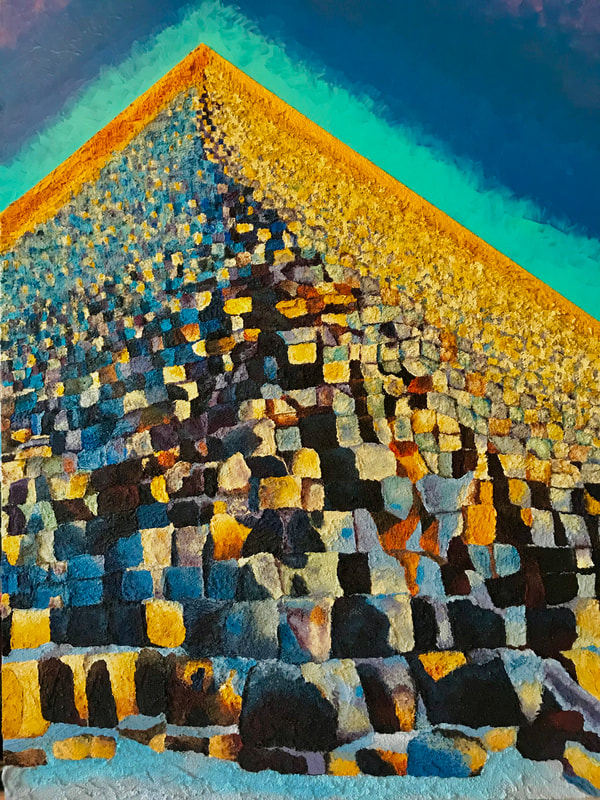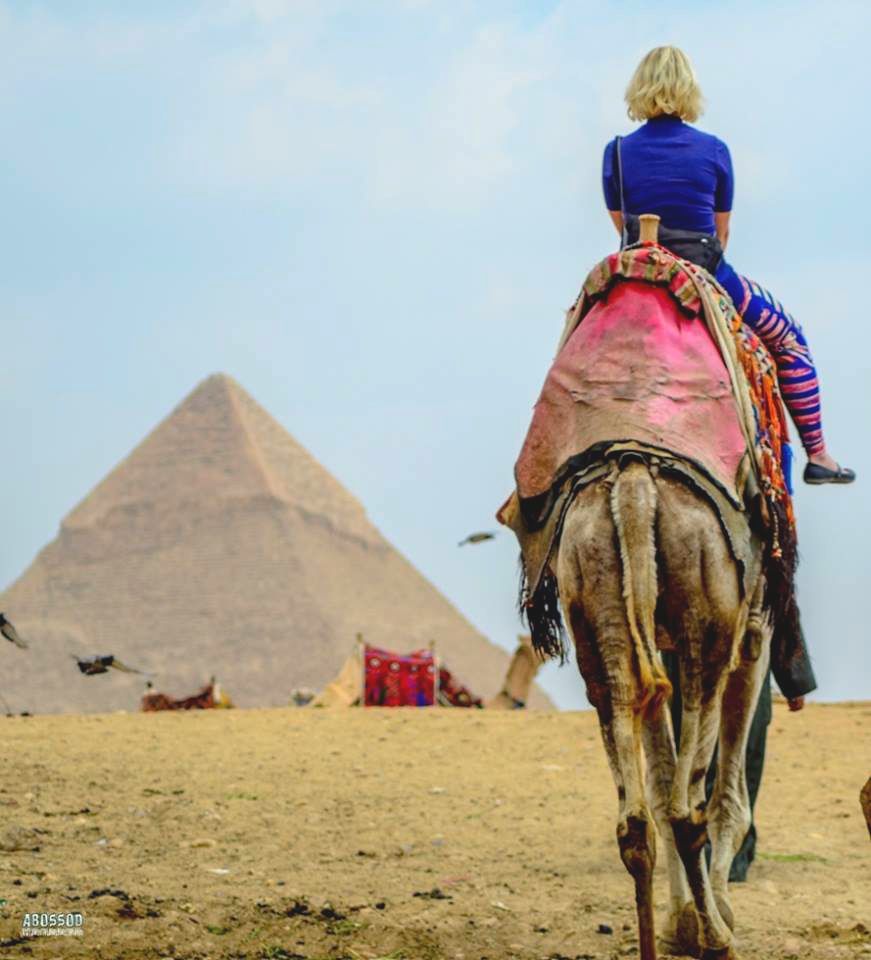Me and a sweet camel in front of the Great Pyramids of Giza, Egypt
In April of 2017, I had a 10-hour layover in Cairo, so I stopped into Giza to explore the Great Pyramids. Pyramids are thought to be extremely sacred in many cultures around the world. Many churches are built with pyramid-like steeples and ancient pyramid constructions can be found not just in Egypt, but also in South America and parts of Asia. Feeling an intense energy of excitement, I later learned that significant sites like this one, and many other sacred palaces, royal burials, or megalithic structures of the ancient world, are built on specific intersections of geologic ley-lines called tuleric lines of electromagnetic currents.
Not only was I captivated by the enormity and shape of the pyramid of Khufu, but also the unique weathered form of each rock. Even though commonly thought to be made of simple stone from nearby quarries, the rocks were from a variety of areas and chosen for their specific qualities. The core of these pyramids are actually made of dolomite, including magnesium as an electricity conductor. Radioactive granite surrounds the sealed shafts that releases a lively radon gas. And, white limestone was used to cover the outer layer of the pyramids. Further, water from the Nile used to run through underground aquifers, a chalk foundation, creating a charge in magnetic field like modern-day hydro-electric damns. Combined with solar power of the sun, in the ancient times (five to seven thousand years ago) these glowing pinnacles acted as illuminated spiritual storehouses, gigantic lightbulbs (The Pyramid Code).
The pyramid is a unique combination of equilateral triangles. The triangle is important to religions, history, and spirituality because of the concept of trinities like mind-body-spirit, past-present-future, life-death-rebirth, Father-Son,-Holy Spirit. In addition, what makes a pyramid so powerful is its ability to channel energy from the higher realms of the stars, the planets and the Universe and deliver it down to earth. Often called prana, chi, or life force energy, this feeling charge of peaceful bliss can also be found on mountain tops and other sacred sites around the world. In this way, the pyramid is a symbol for the integration of self-and soul. The bottom of the pyramid represents a solid, earthy foundation, whereas the pointed top represents being able to reach into higher realms of consciousness. Because of its shape, any energy that enters the pyramid has the ability to be cleansed and purified. This is because pyramids are said to generate negative ions which can balance the body’s electromagnetic field and act as powerful healing chambers.
Great Pyramid of Sacred Energy by Hannah Faulkner
I aimed to capture this phenomenon in my most recent painting called Great Pyramid of Sacred Energy. Made of sand mixed into paint, on a 30” x 40” wood panel, I capture the contrast of self and soul, negative and positive charge, consciousness and earthy foundation with layers and layers of form, texture, and contrasting colors. See it up close and personally at my upcoming showcase, Conception Art on Saturday, December 8th from 6-10pm at Mission Brewery (1441 L Street San Diego, CA). Or, my next RAW showcase on January 17th.
Pyramid Pose
In the physical practice of yoga postures, Pyramid Pose is an asana that represents not only the yogic trinity of mind, body, and spirit, but also the integration of a solid earthly balanced self, and higher consciousness in surrender.
Known as Parsvottanasana in Sanskrit, it translates to "intense side stretch" as we take turns leaning into one side of the body at a time, strengthening the legs, stretching the spine, calves, hamstrings, and shoulders.
With squared hips and legs separated three to four feet apart, the front and back heels are lined up with one another, while the toes are pointing forward. For a less challenging variation, move the right foot slightly to the right to create a more stable foundation, then lower the fingertips down to either side of the front foot onto blocks.
Otherwise hands can start off on the hips, clasp together at the lower back, or come into reverse anjali mudra (or grasp opposite elbows). Another variation is to clasps thumbs together with palms pressed in straight arms overhead, on an inhale, before draping the torso over the front shin and dropping the head (fingertips will then descend to the earth), on the exhale.
Straightening the legs and pressing into all four corners of each foot (like the solidity of the four corners in a pyramid), reach the crown of the head forward with a flat back. Directing your gaze, drishti, to a point on your knee or the floor, this balance requires patience and concentration.
With the core abdominal organs activated, this pose also improves digestion. To come out of the pose, gently bend into the front leg and lift the heel up on the back leg. Repeat on other side. With dedication to your breath, alignment, and focus, you can develop peace that endures, the same effect that the ancient pyramids gave.
In the physical practice of yoga postures, Pyramid Pose is an asana that represents not only the yogic trinity of mind, body, and spirit, but also the integration of a solid earthly balanced self, and higher consciousness in surrender.
Known as Parsvottanasana in Sanskrit, it translates to "intense side stretch" as we take turns leaning into one side of the body at a time, strengthening the legs, stretching the spine, calves, hamstrings, and shoulders.
With squared hips and legs separated three to four feet apart, the front and back heels are lined up with one another, while the toes are pointing forward. For a less challenging variation, move the right foot slightly to the right to create a more stable foundation, then lower the fingertips down to either side of the front foot onto blocks.
Otherwise hands can start off on the hips, clasp together at the lower back, or come into reverse anjali mudra (or grasp opposite elbows). Another variation is to clasps thumbs together with palms pressed in straight arms overhead, on an inhale, before draping the torso over the front shin and dropping the head (fingertips will then descend to the earth), on the exhale.
Straightening the legs and pressing into all four corners of each foot (like the solidity of the four corners in a pyramid), reach the crown of the head forward with a flat back. Directing your gaze, drishti, to a point on your knee or the floor, this balance requires patience and concentration.
With the core abdominal organs activated, this pose also improves digestion. To come out of the pose, gently bend into the front leg and lift the heel up on the back leg. Repeat on other side. With dedication to your breath, alignment, and focus, you can develop peace that endures, the same effect that the ancient pyramids gave.
Initial set up of Pyramid Pose before folding over the front leg


































